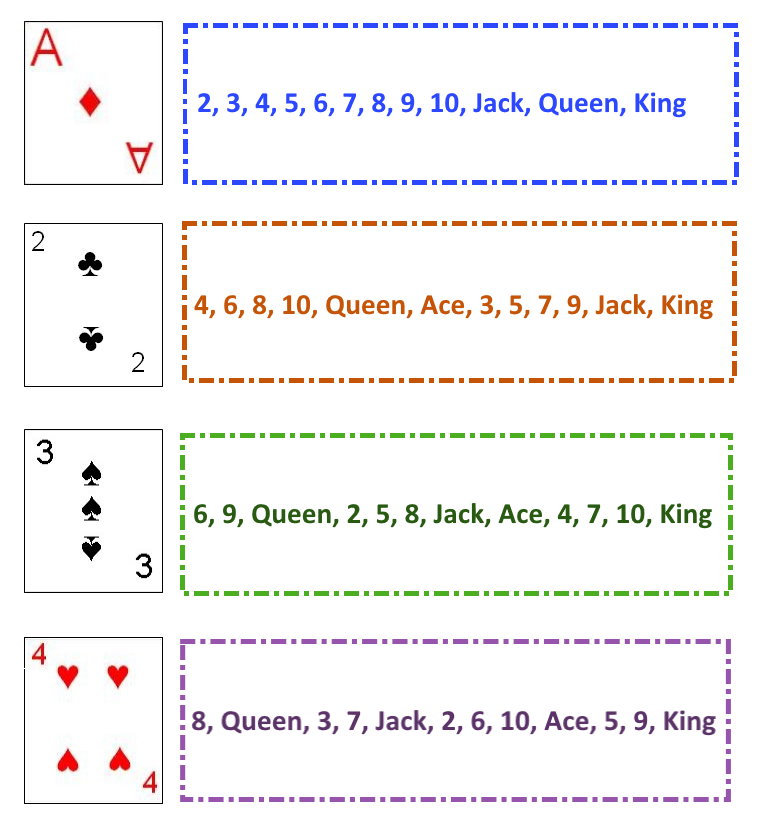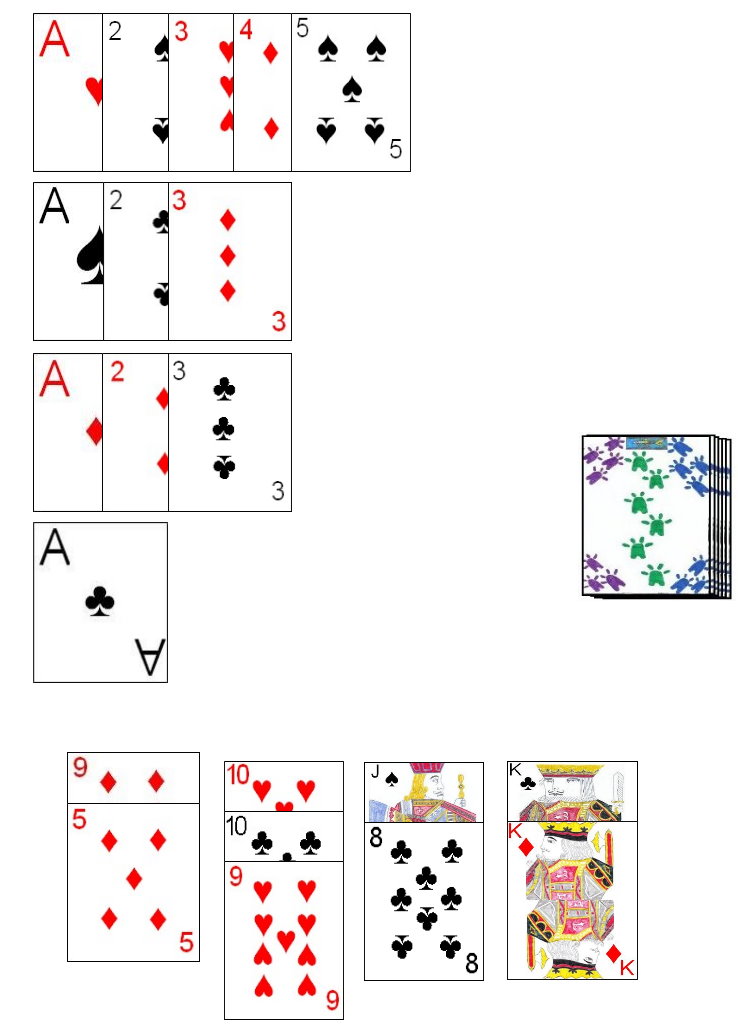 To begin one Ace, one two, one three and one four should be removed from the deck and placed on the table in four rows to start four foundation piles. These cards can be of any suit, as the suits of cards in this solitaire game do not matter.
To begin one Ace, one two, one three and one four should be removed from the deck and placed on the table in four rows to start four foundation piles. These cards can be of any suit, as the suits of cards in this solitaire game do not matter.
The object of Calculation is to play all 52 cards from the deck onto these four foundation piles. However, the catch is that each foundation pile is built upon in a very specific way. The following indicates how each foundation pile is built:
- The first foundation pile, which is started with the Ace: This pile builds in the traditional method. Starting with the Ace which has already been played, the player then builds on this pile by adding the next card in rank from the current card on the top of the pile. Thus, the sequence of cards on this pile would be build in the following order (Ace, 2, 3, 4, 5, 6, 7, 8, 9, 10, Jack, Queen, King.)
- The second foundation pile, which is started with the two: This pile is built upon in increments of two each time. Thus, cards would be built onto this foundation pile in the following order: 2, 4, 6, 8, 10, Queen, Ace, 3, 5, 7, 9, Jack, King.
- The third foundation pile, which starts with a three: This pile is built in increments of three. Therefore, the cards would be built onto this foundation pile in the following order: 3, 6, 9, Queen, 2, 5, 8, Jack, Ace, 4, 7, 10, King.
- The fourth foundation pile which is started with the four: This pile is built onto in increments of four. Thus, the ordering for play of cards to this foundation would be as follows: 4, 8, Queen, 3, 7, Jack, 2, 6, 10, Ace, 5, 9, King.
After the initial four cards to start the four foundation piles have been removed from the deck and placed on the layout, the remainder of the deck should be shuffled and placed on the table as the draw pile.
Play consists of dealing the top card of the stock pile and playing this card as able. If the card can be placed next in proper sequence on the top of any of the foundation piles it may be played there (but is not required to be played there at this time). If the card cannot be played to one of the foundation piles, the player must play it to one of four personal piles, called waste heaps. At the start of the hand, these piles will contain no cards, so the player may start these piles with any card. In addition, any card may be played to the top of an existing waste piles, regardless of rank or suit. The top card from a waste pile may be played to one of the foundation piles if that top card is the next in logical sequence for that foundation. The top card of a waste pile may never be moved to another waste pile. If, at any time, the player find he has less than four such waste piles, he may start a new waste pile with any card.
The game continues with the player continuing to deal the cards from the stock and play them as appropriately (to the foundation piles or the waste piles). At any time a player may also make a legal play from a waste pile to a foundation if applicable. After the deck has been exhausted, the player may continue to make any available legal plays from the waste piles.
If the player manages to complete all four foundations (using the specific ordering for each foundation), he is said to have won the game. The win ratio for Calculation is estimated to be approximately 20%.
Variations and Optional Rules
No Starting Layout: A somewhat more challenging variation of Calculation is sometimes played. In this variant, no initial cards are removed from the deck to start the layout. Instead, the layout begins empty and the four initial cards must be played to begin each row in the layout just as the player would play additional cards to these layouts. Thus, for the first row an Ace must be played before the next card can be played to that row, in the next row a two, in the third row a three and in the fourth row a four. Other than starting with no initial layout, the game is played identically to the standard game, and if the player manages to complete all four rows of the layout he is said to have won.
 Sir Tommy: Sir Tommy is thought by many card scholars to be the earliest form of card building game and is also the direct ancestor to Calculation, described above. It can be thought of as a
somewhat simplified version of Calculation as described above. Sir Tommy is also known by several other names including Old Patience, Numerica and Try Again.
Sir Tommy: Sir Tommy is thought by many card scholars to be the earliest form of card building game and is also the direct ancestor to Calculation, described above. It can be thought of as a
somewhat simplified version of Calculation as described above. Sir Tommy is also known by several other names including Old Patience, Numerica and Try Again.
Sir Tommy is also designed to be played by one participant and uses one standard 52 card deck. The ranking of the cards in this deck are as follows (from lowest to highest): Ace, 2, 3, 4, 5, 6, 7, 8, 9, 10, Jack, Queen, King.
No starting layout is created in Sir Tommy, thus to begin the game, the deck is thoroughly shuffled and placed face-down on the table as the stock. The cards are dealt from this pile one card at a time. If the card is an Ace, it can be used to start one of four new foundation piles. Each of these four foundation piles is then built onto in the following normal sequence; Ace, 2, 3, 4, 5, 6, 7, 8, 9, 10, Jack, Queen, King. Thus, if the card dealt from the stock is the next in sequence of the top card on an existing foundation he may play the card to the top of that foundation. The suits of the cards does not matter, so as long as the card is next in sequential rank (of any suit) to the current top card of the pile, it can be played to the top of that foundation pile.
If the card cannot be played to a foundation (or the player chooses not to at this time), the card must be played to one of four waste piles. Initially, these piles will be empty, containing no cards. The player will then create these waste piles with cards dealt from the stock that cannot necessarily at that time be used to play to a foundation pile. Any card can be played to the top of a waste pile or to start a new waste pile (if the player currently has less than four such piles). A card on the top of a waste pile may never be moved to another waste pile, but it may, if the cards is next in sequence for any of the foundation piles, played to that foundation pile.
The game is considered won if the player manages to build each of the four foundation piles from Ace to King. Sir Tommy is slightly harder to win than it's descendant game Calculation, with the average win ratio for Sir Tommy to be approximately 15%.
Strategy: Strategy is another early card building solitaire game and is considered a rather more difficult version of Sir Tommy. The game is designed for one player using one standard 52 card deck.
To begin, the cards are thoroughly shuffled by the players and the deck is placed in the center of the table as the stock pile. Similar to Sir Tommy, the object of Strategy is to build up four foundations from Ace to King in sequence. Thus, play consists of the player dealing the cards one-by-one from the top of the stock pile. If the card is any Ace he plays it to the tableau to begin one of four foundation piles. In addition, if there are one or more foundation piles which have already been started he may play the card to that foundation pile as able. To play a card to a foundation pile, it must be the next in sequence as the current top card of that foundation pile AND must be of the same suit as the other cards in the same foundation pile.
If a card cannot be played to a foundation pile, the player must play the card to one of four waste piles that he will create. Initially, these four waste piles are empty, so the player may start up to four new waste piles with any card of his choice. He may also play any card to the top of any waste pile, regardless of that card's rank or suit. At any time, if the top card of a waste pile is of the same suit and next in sequence as the top card on one of the foundation piles, he may play that card to the appropriate foundation pile. Play continues with the player dealing each card from the deck and making any legal plays from the waste pile to the foundation piles. A card may never be moved from one foundation pile to another.
The player is considered to have won the game if he is able to build each of the four foundations from Ace to King, one pile in each suit. The win ratio for this Solitaire game is approximately 14%.
Copyright © 2015 CatsAtCards.com. All rights reserved.